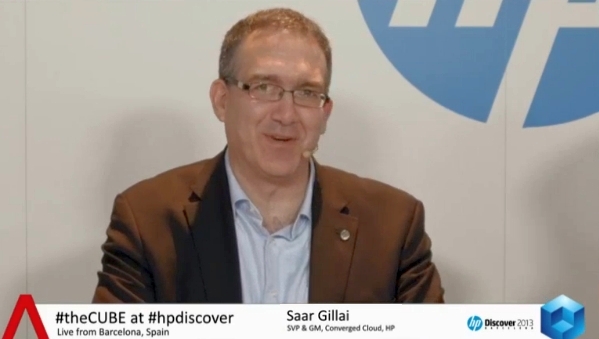 NEWS
NEWS
 NEWS
NEWS
 NEWS
NEWS
![]() During Day 2 of HP Discover 2013 in Barcelona, John Furrier, theCUBE host and SiliconANGLE co-founder, managed to talk with Saar Gillai, SVP & GM of HP Converged Cloud, about OpenStack and – what else? – the cloud.
During Day 2 of HP Discover 2013 in Barcelona, John Furrier, theCUBE host and SiliconANGLE co-founder, managed to talk with Saar Gillai, SVP & GM of HP Converged Cloud, about OpenStack and – what else? – the cloud.
Saar has appeared in several other features from theCUBE, and his segment was expected with great anticipation. Curious to find out what has happened since the last discussion, Furrier asked Gillai to summarize the Converged Cloud activity.
“We’ve made a lot of progress since our last talk. We wanted to have a single unit to cover cloud all the way from consume to build. We released Cloud OS. We said that we wanted to make the cloud easier for our customers to consume, so we built our separate Go to Market organization that handles cloud. From an engineer side, we now have all the core technology under one business unit, that builds the whole core technology for the public and the private cloud in one place. That helps us create one consistent architecture for all cloud, whether it’s public, private or managed,” said Gillai.
“Early on I was very critical of HP cloud,” confessed Furrier, who went on to congratulate Gillai for the recent accomplishments of his team. “The cloud wasn’t coherent enough in the beginning, but now you got it in a really good position,” admitted Furrier. He asked Saar to take the viewers through a play-by-play on the execution that made it all possible, on the product side and on the engineering side.
“It all started with support from Meg Whitman. When I took over, 15 months ago, we had a good strategy, we had a bunch of products, but it was all very silo-ed. We realized that when we were trying to figure out the best way to move forward. Mark Potter, our CTO, came up with a strategy, and we identified two challenges: 1) all engineering was silo-ed, and even if all the people had the right motivation, it was very hard to focus on the long-term stuff; 2) the Go to Market was also very silo-ed. Everybody knew what needed to be done, but no one knew exactly how to do it,” remembered Gillai.
“So we put together a plan to start consolidate engineering,” he continued. “Then we started working with the private cloud guys and the public cloud guys in the same organization, as we are supposed to be the same thing, we started charting out how to consolidate the sales team. Over the last 12 months we’ve basically charted the path, we brought in a lot of talent, and we persuaded the Board that we wanted to increase the investment dramatically.”
“What’s the big going forward piece?” asked Furrier. “Are you still committed to OpenStack ?”
“We are all in with OpenStack. We’ve been supporting it since day one and so far we proved to be correct; I’m not going to show our hands,” joked Gillai, “but I’m going to say that the level of investment we’re putting in is going to surprise people dramatically. Not everything that we’re doing is clear yet, but it will become clear over time. When I say over time I mean over the next 12 months, not the next 12 years. The cloud is a monthly thing, not a yearly thing. What’s really important now in OpenStack is the move from a developer focus to a customer focus,” explained Gillai.
Furrier mentioned that the customers he has spoken to indicated that the first thing they needed was flexibility, and they wanted OpenStack to be that for them. For the time being, OpenStack seems a bit lost, at least according to Furrier. “RackSpace is there, but they don’t have the right mojo on the software side because they are hardware guys. HP is there, but they are hosting guys. IBM really made Linux work,” stated Furrier.
“I think Amazon did a great job in the first wave of cloud, but the first wave is small compared to the rest of the waves that are coming. There are more people working on OpenStack than there are in Amazon. Amazon may be ahead, but if you look at the curve, our slope is better. Solaris was good too, but one morning Linux came along, and it took a while for Linux to go over Solaris, but today nobody even talks about them. OpenStack is doing in a few years what it took Linux over a decade to do,” predicted Gillai.
Talking about the trends, Gillai recounted: “The first wave was the low-hanging fruit. The second wave is hybrid cloud, and the realization it’s not this versus that, but people being able to do both.” As for the future, “if there are companies out there who think they’re going to make all their money on OpenStack, they are going to have a business model problem against HP,” warned Gillai. “HP cloud is built on OpenStack.
Support our mission to keep content open and free by engaging with theCUBE community. Join theCUBE’s Alumni Trust Network, where technology leaders connect, share intelligence and create opportunities.
Founded by tech visionaries John Furrier and Dave Vellante, SiliconANGLE Media has built a dynamic ecosystem of industry-leading digital media brands that reach 15+ million elite tech professionals. Our new proprietary theCUBE AI Video Cloud is breaking ground in audience interaction, leveraging theCUBEai.com neural network to help technology companies make data-driven decisions and stay at the forefront of industry conversations.